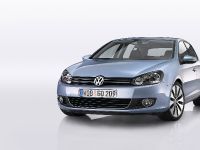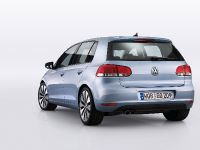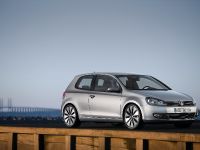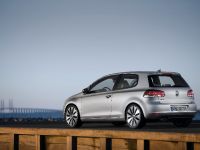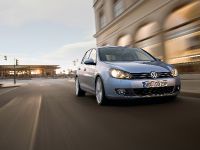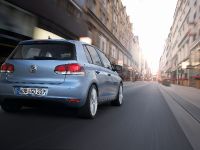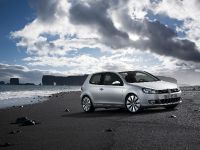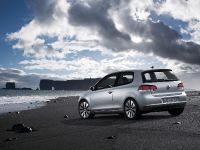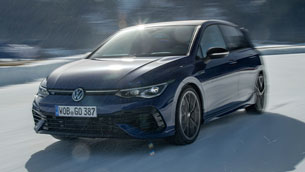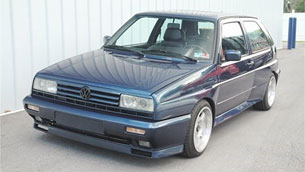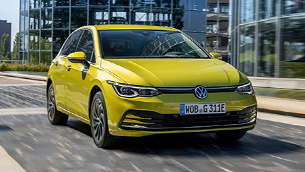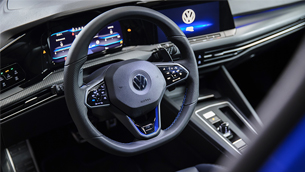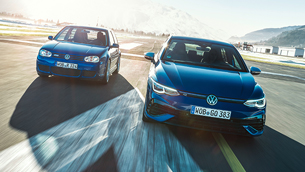The New Golf – International Driving Presentation
The Best Golf of All Times • Golf's high customer value and comfort defy class distinctions • New Golf design points the way to Volkswagen's future • TDI, TSI and DSG systems reduce fuel consumption by up to 28 percent • First Golf with Adaptive Chassis and Automatic Distance Control
Wolfsburg, September 2008. Volkswagen is sending a new Golf out into the world, the best of all times. The Golf is a phenomenon, regardless of its particular generation. Positioned in the compact class, this style icon defies all automotive and social class distinctions. No other car in this price segment has even come close to reaching as large a cross-section of people. The Golf is the only one that always fits right, and the new one is even better fitting.
It was perfected in every detail. It is also the quest for perfection that has elevated the styling of the Golf to a new level. The team headed up by the Group's chief designer, the Italian Walter de Silva, has succeeded in giving the Golf a presence, a sharpness, a power that generates even more fun. Fun to look at and fun to drive. An intelligent car. Data such as an average fuel consumption of 4.5 liters per 100 kilometers for a 110 PS TDI put fuel prices in their place. Upon request, the Golf can park itself nearly automatically in the city thanks to "Park Assist", it can maintain an ideal gap on the freeway by distance control (ACC), and at the push of a button it can transform itself from a cruiser to a sports car when the new "DCC Adaptive Chassis Control" system is on board.
Above all, the car exhibits a standard of quality never before attained in this price class. Prof. Dr. Martin Winterkorn, Chairman of the Board at Volkswagen AG sums it up: "This sixth generation of Golf cars will completely redefine the quality and comfort level of its class over broad categories, offering more customer value than ever before". In Europe the new Golf will be introduced to the market in October. Following in succession will be Africa, Asia, Australia and North America.
Innovative force – the Golf democratizes progress
The clear and powerful styling of the Golf being offered as a two-door and four-door in the "Trendline", "Comfortline" and "Highline" equipment lines is showing the entire brand the way to the future. The Volkswagen's acoustic properties and overall comfort tear down class distinctions. Innovative engine and transmission technologies reduce fuel consumption by up to 28 percent. All gasoline and diesel engines fulfill emission limits of the future Euro-5 standard.
Assistance systems such as "ACC Automatic Distance Control" – as well as developments like "DCC Adaptive Chassis Control" (DCC) and "Park Assist" – bring additional top technologies to the Golf class. A new ESP system, with finer response over its control range, further optimized crash properties, seven airbags including knee airbag, the special head restraints (WOKS) that work to counteract whiplash trauma, a "seatbelt detection" feature debuting on the Golf in the rear seating area and daytime running lights – also standard equipment – provide for a maximum level of safety.
Exterior design – precision in a new form
The exceptionally high value of the new Golf is reflected par excellence in its stylish design; all key body elements were redesigned: "We have cast the Golf's core components in a precise new mold", explains Walter de Silva. And he emphasizes this: "The Golf is the global icon of car making. So the architecture and styling of new model are also absolutely clear and unique." At the same time, the sixth Golf has a sportier and more distinctive image than any previous generation of the model series. De Silva: "It is more accentuated, more three-dimensional than its predecessor; with precisely defined lines and edges, and with finely proportioned flared surfaces and recesses." And Klaus Bischoff, Chief Designer for the brand, adds: "Every detail is uncompromisingly aimed at improving value."
Especially in a direct comparison of generations V and VI, it becomes evident just how much the new Golf has changed. The design team – headed up by Walter de Silva, Klaus Bischoff and the Group's director for creative design, Flavio Manzoni – crystallized out the Golf's essential DNA and sent it on a trip to the future. Style features include the clarity of the first generation's front end and the C-pillar that was perfected in the fourth generation.
The roof section now rests – similar to the new Scirocco – on a prominently contoured shoulder section. Responsible for this is a dominant curved line that – like a muscle trained down to the last fiber – extends from the headlights back to the taillights. This side profile line – which Volkswagen Design calls the "character line" – also gives the Golf a fuller, lower stance on the road from a lateral perspective.
All body surfaces are more relaxed, more athletic. In front the new car adopts the radiator grille of the first Golf generation that is horizontally aligned between the headlights; the grille itself is in high-gloss black. The lines of the bumper match those of the radiator grille. Beneath this is a section with another air scoop. Also presented over a black background are the chrome light housings of the dynamically styled headlamps.
The rear too is characterized by a predominance of horizontal lines. The taillights – now very wide – are marked among other things by an unmistakably unique night design. Stylistically, the crystal-clear line of turn signal and backup lamps bears a resemblance to the taillights of the Touareg. Overall, the new Golf – in the interplay of all of its design characteristics – gives the appearance of a significantly wider, flatter and higher end car.
Interior – imploding class distinctions
The car's exceptionally high value also applies to the newly designed interior, whose refined surfaces and features completely transform class distinctions, both to the touch and visually, especially in the cockpit area. The appearance and layout of materials – as well as details such as brushed chrome accents and round instruments and steering wheels derived directly from those of the Passat CC – leave the impression that one is actually sitting in a car of the next higher segment. Ergonomic properties of the car's interior were also further developed. For example, all controls are even easier to use. They include controls for the automatic climate control system (Climatronic) being presented for the first time on the Passat CC, the new RNS 310 radionavigation system with touchscreen and the power window controls that are now located further forward in the door trim, making them easier to access.
There is a common thread here: Volkswagen's typical attention to perfection of every detail in the car. Take the example of "seatbelt detection" in the rear: if rear head airbags are ordered on the Golf, the driver can tell from the multifunctional display in the cockpit and an acoustic warning whether the occupants have their seatbelts fastened in the rear – separately for each seat. Or take the example of leather seats: a new, more robust leather is being used for the first time on the Golf. Or the cargo area: on the new Golf too, four practical hooks ensure that the contents of shopping bags are not strewn across the cargo area after shopping. Or the outside mirrors: thanks to their aerodynamically optimized shape they get significantly less dirty. They are easier to adjust from the inside, since the power mirror adjustment control is now located higher and further forward in the door trim.
Low-noise comfort – the quietest Golf since the model series began
The new Golf is characterized by first-class acoustic properties. A special sound-damping film in the windshield reduces driving noises, as does the newly developed seal design on the doors and side window guides. Significantly less wind noise is generated by the outside mirrors due to their new shape. Furthermore, special modifications were made to better isolate the engine and passenger compartments from one another acoustically. Quiet rolling tires and new engine bearings round out the noise reduction program.
Diesel engines – the shift to common rail injection
Making a significant contribution to the pioneering acoustic properties of the Golf are the exceptionally quiet common rail TDI engines being implemented on the Golf for the first time. Two balancer shafts (from 103 kW / 140 PS) also eliminate undesirable vibrations. Plans call for a TDI power range from 66 kW / 90 PS to 125 kW / 170 PS. Right at its market launch Volkswagen will be offering two 2.0 liter TDI engines on the Golf; they deliver 81 kW / 110 PS and 103 kW / 140 PS. Always there: a diesel particulate filter (DPF).
The new TDIs are exceptionally fuel efficient. The 110 PS strong diesel is satisfied with just 4.5 liters of fuel per 100 kilometers (119 g/km CO2) – that represents a 0.6 liter reduction in fuel consumption! Even the 140-PS version only requires 4.9 liters of diesel (129 g/km CO2), which is 0.6 liter less than the on the previous generation.
Gasoline engines – more fuel efficient than ever before
In the launch phase, four variants will define the range of gasoline engines with 59 kW / 80 PS, 75 kW / 102 PS, 90 kW / 122 PS and 118 kW / 160 PS. Starting at 90 kW / 122 PS, TSI engines with supercharging and/or turbocharging are used. The fact is: the gasoline engines are also pioneers in economy. The optimized 80-PS entry-level engine consumes just 6.4 liters Super per hundred kilometers (149 g/km CO2) – that is 0.5 liter less than its predecessor. The TSI engines once again make their appearance as prime examples of efficiency: with 122 PS the new Golf 1.4 TSI consumes just 6.2 liters Super (144 g/km CO2); this represents a fuel consumption advantage of 0.1 liters. Even the new 160-PS top version of the 1.4 TSI achieves a top value at 6.3 liters. The 160-PS TSI's fuel consumption too was lowered by 1.6 liters compared to the retired 150-PS FSI. DSG – replaces conventional automatic
With the exception of the entry-level versions, all gasoline and diesel engines may be paired with Volkswagen's dual clutch transmission (DSG). Either a 6-speed or 7-speed DSG is used, depending on engine torque. This means that on the Golf the extremely efficient and agile DSG has replaced the classic torque converter automatic. Just how economical the alliance of TSI plus DSG can be is demonstrated by the example of average fuel consumption on the 1.4 TSI with 160 PS and 7-speed DSG: 6.0 liters (139 g/km CO2). This high-tech duo replaces the 2.0 FSI with 150 PS and 6-speed automatic. Average fuel consumption there: 8.3 liters. Savings: 2.3 liters per hundred kilometers or 28 percent – progress at its best.
Golf Facts Sheet
Key aspects in alphabetical order
• Automatic transmission: 6 and 7-speed DSG
• Body: two and four doors with tailgate; key body sections are galvanized
• Cargo area: 350 liter to 1,305 liter, 828 mm to 1,581 mm long
• Character: bestseller, at home in all social classes
• Chassis: MacPherson front suspension, multi-link rear suspension, ESP is standard, DCC Adaptive Chassis Control (optional)
• Colors: "Candy white", "Black uni", "Tornado red", "Shark blue metallic", "Amaryllis red metallic", "Reflex silver metallic", "Shadow blue metallic", "Silverleaf metallic", "United grey metallic", "Blue graphite pearl effect", "Deep black pearl effect"
• Debut: Generation I: 1974
• Debut: Generation II: 1983
• Debut: Generation III: 1991
• Debut: Generation IV: 1997
• Debut: Generation V: 2003
• Debut: Generation VI: 2008
• Design: Walter de Silva (Group), Klaus Bischoff (Brand), Flavio Manzoni (Creative Design), Marc Lichte (Model)
• Dimensions: 4,199 mm long, 1,779 mm wide, 1,479 mm tall, tread width, front 1,540 mm; tread width, rear 1,513 mm
• Drive: front wheel
• Engine range: 59 kW / 80 PS to 125 kW / 170 PS; starting at 90 kW all gasoline engines are charged TSI engines; all diesels are new common rail TDI engines; all engines fulfill Euro-5 emissions standard
• Engines – diesel: at launch with 81 kW / 110 PS (TDI), 103 kW / 140 PS (TDI); after time offset: 66 kW / 90 PS (TDI) and 125 kW / 170 PS (TDI)
• Engines – gasoline: at launch with 59 kW / 80 PS, 75 kW / 102 PS, 90 kW / 122 PS (TSI), 118 kW / 160 PS (TSI)
• Equipment lines: Trendline, Comfortline, Highline
• Fuel consumption range: 4.5 liters to 7.1 liters per 100 kilometers
• High-tech driving systems: DCC Adaptive Chassis Control, ACC Automatic Distance Control, Park Assist, Rear Assist rearview camera, Park Pilot with visual display
• Infotainment: RDC 210, RDC 310, RDC 510 radio-CD player systems; RNS 310 (completely new) and RNS 510 radio-navigation systems; MEDIA-IN port, AUX-IN port, Excite Dynaudio sound system, hands-free unit
• Market launch: starting in October 2008
• Produced Golf cars, total: more than 26 million
• Production sites: Zwickau and Wolfsburg
• Standard equipment: includes ESP, seven airbags, air conditioning system, electro-mechanical power steering, power windows in front, multifunctional display, central locking, driver's seat height adjustable
• Standard transmission: 5 and 6-speed manual transmission
